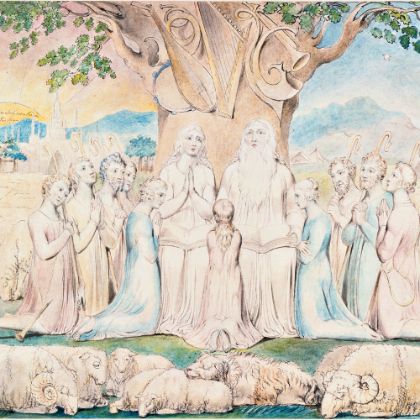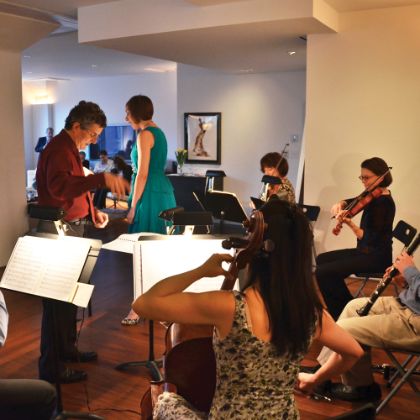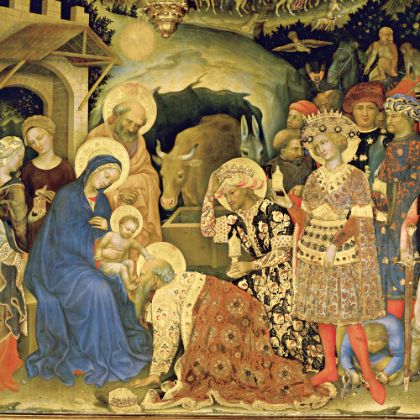What Were All Those Sorrowful Songs About?
Henryk Górecki’s Third Symphony is a chart-topping anomaly.
By Daniel Felsenfeld
In 1992, a recording of a virtually unknown composer’s mournful, hour-long, sixteen-year-old, Holocaust-reminiscing symphony not only topped the classical charts for a full year but also cracked the British pop charts. In a world where classical record sales usually top out in the hundreds, where large lights like Yo-Yo Ma and Joshua Bell are fortunate to crack the tens of thousands, the Nonesuch Records recording of Henryk Górecki’s Symphony of Sorrowful Songs made history, selling upwards of a million copies. But despite the overwhelming success of this record — a success no classical artist has ever duplicated (save for one Billy Joel, whose record of solo piano music, Fantasies and Delusions, sold equally well) — it did not especially help Górecki’s career, at least not proportionally.
When he died late last year, months shy of his seventy-seventh birthday, the run of obituaries outlined his career — his journey from European avant-garde high-modernism to reflective, mystical tonal purity, a not uncommon trajectory — and claimed that while the monumental success of his Third Symphony had taken him from obscurity to fame, it had failed to elicit interest in his other works. He did receive other commissions: His Fourth Symphony, a joint commission between the Los Angeles Philharmonic and the London Symphony Orchestra, lies unfinished, as does a Fourth String Quartet for Kronos Quartet. Nevertheless, Górecki — perhaps for reasons of temperament, perhaps due to ill health, certainly for reasons we will never understand — never quite managed to keep his status as a globally recognized musical figure.
The composer spent much of his life in the company of death. Born in 1933, he lost his mother when he was two years old, and throughout his life he was plagued by ill health, resulting in the loss of several fingers. But more than that, he grew up in Nazi-occupied Poland, in Silesia, a place so polluted it snowed black and so devoid of an intelligentsia it had no cultural life. “Auschwitz, our most famous place, was twenty minutes away,” he said in an interview with filmmaker Tony Palmer. “I remember when I was twelve years old, we went out on a school visit to Auschwitz. I had the feeling the huts were still warm.” This was in 1945. “The paths themselves — and this image has never left me — the paths were made from human bones thrown onto the path like shingles. We boys — how to walk on this? This is not sand, not earth. We were walking on human beings.” This, as one can imagine, left quite an impression — and Palmer’s film, a just-north-of-poor-taste documentary/concert performance (it accompanies Górecki’s music with brutal footage of not only desiccated concentration camp inmates but also starving Ethiopian children and Serbs being shot) captures the composer on a later visit to the camp, wandering the snowy grounds. “The only way,” he says, “to confront this horror, to forget — but you could never forget — was through music.”
Critic and blogger John Bailey sums up the work aptly. He writes:
The Third Symphony is composed in three rather than the traditional four movements, each one a dirge of loss. The text of the first movement comes from a fifteenth-century Polish lament of the Holy Cross; the third, from a Silesian folk song of a mother searching for her lost son killed in an uprising. But it is the second movement, the shortest of the three, which has become the focal point of the work. Its text [‘Oh Mamma do not cry — Immaculate Queen of Heaven support me always’] was scrawled on a cell wall at Gestapo headquarters at Zakopane, Poland, by an eighteen-year-old prisoner named Helena Wanda Blazusiakowna.
(Blazusiakowna was not murdered there; when the train she was on, bound for Auschwitz, was taken over by Polish partisans, she escaped. She later married, had five children and died in 1999.)
Not without cause, Górecki is often grouped with the other so-called “Holy Minimalists,” a buzz-phrase for the European-Catholic God-drenched works by the likes of Arvo Pärt, Giya Kancheli and John Tavener — setting them apart from, say, the West Coast minimalism of Terry Riley and Lou Harrison or the Asphalt Jungle pulses of Steve Reich and Philip Glass. Górecki wrote his piece in 1976, in an era when an aesthetic retrenchment to simpler modes and reactions against atonality were not uncommon, even de rigueur. Many composers were acquiescing to what even Schoenberg, the architect of non-tonal music, discovered at the end of his life: that tonal harmonies could be used to say things that were just as profound, and that rebellion could be just as easily cast in F Major.
In 1992, the Symphony of Sorrowful Songs spoke to an overarching cultural need. Alex Ross, in his book The Rest Is Noise, postulates on why composers like Górecki “achieved a degree of mass appeal during the global and economic booms of the eighties and nineties.” His reason: “They provided oases of repose in a technologically oversaturated culture.”
The same public that rushed to the now-defunct Tower Records to buy Symphony of Sorrowful Songs became fascinated with angels (Wim Wenders films like Faraway, So Close, Tony Kushner’s epoch-making Angels in America), a certain marketable idea of the ancient and celestial (discs simply called Chant, sometimes sold with matching monk hoods advertised as being “perfect for praying or partying”) and a widespread pop-cultural squaring with the Holocaust (Schindler’s List). Górecki’s dirge simply hit a sweet spot in the center, an Adagio for Strings for the postmodern era, the non-ironic music of renewed faith.
Whether that faith was non-ironic bears some scrutiny. Critic and author Michael Steinberg wondered if people were, in fact, “really listening,” or just using it as “background music to Chardonnay and brie.” In an especially withering posit, he asked, “How many CD buyers discover that fifty-four minutes of very slow music with a little singing in a language they don’t understand is more than they want?” He likened the work to Doctor Zhivago, a book that, according to him, many purchase but few read. On the other hand, his pessimistic assessment of the million Sorrowful Songs customers might come out of the customary insider’s position of envy, or the received idea that the best music is beyond the comprehension of the general public.
Apart from being a still-beautiful, moving piece of music, like most masterworks of classical music, Symphony of Sorrowful Songs stands as a long, slowly unfolding document of a vanished era, a synecdoche of its time.
Contra to Mr. Steinberg, over one million people simply cannot be wrong. There must have been something about the piece itself that appealed — and continues to appeal — to such a broad spectrum of the citizens of Planet 1992. “I was tremendously moved by it when I first heard it,” says author and musician Rick Moody, “and I still do think the [Dawn] Upshaw recording is stately and beautiful. There is for me, and I hesitate to say this to my more sophisticated composer friends, real value in some of Górecki. I have not yet concluded that all traditional tonality is simplistic and/or sentimental. If you’re going to have it, tonality, why not use it to say something really important? This is what Górecki seemed to do in that case: used a very conventional melodic structure to say something rather profound about the war and its legacy and, especially, about Poland’s part in all of that.”
More than any cultural, visceral or technical aspect of the phenomenon that was the Symphony of Sorrowful Songs, the work itself touches on our fascination with the unknown, the ancient and the intangible, all the while giving the public exactly what it wants. Tensions resolve, bleak dissonances turn pure, no death exists without its attendant transfiguration. Things — even the worst, most untenable, ghastly things — can, through the power of longing, looking up, and above all, the power of singing, resolve to a repeated major chord.
“The world today, it’s the same,” said Górecki. “Also a nightmare, crushing us. I had to take a stand, as a witness and a warning. There is so much evil around us, we have to try to look for something positive. Even in the worst person, you hope to find something good. This is absolutely important. My Third Symphony, yes, it’s tragic, but not in the sense of tragedy. I wanted to express great sorrow. The war, the rotten times. And today, the starving in Bosnia, and why? Why? This sorrow, it burns inside of me, I cannot shake it off.”

-

A Father's Lament
Finding solace in the sound of authentic sorrow
Read More
By Rev. Jake Bohstedt Morrill -

The Next (Not-So-)Big Thing
New chamber orchestras are popping up all over America.
Read More
By Colin Eatock -

From Christemasse to Carole
The birth of Christmas in medieval England
Read More
By David Vernier